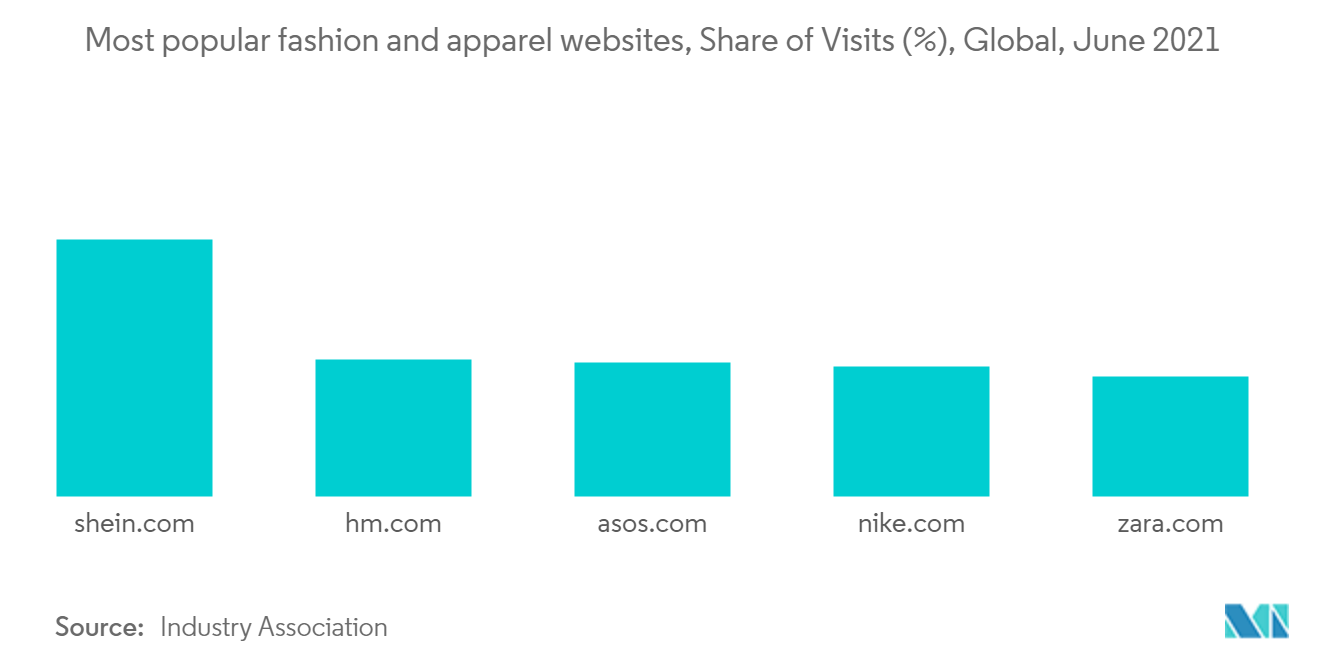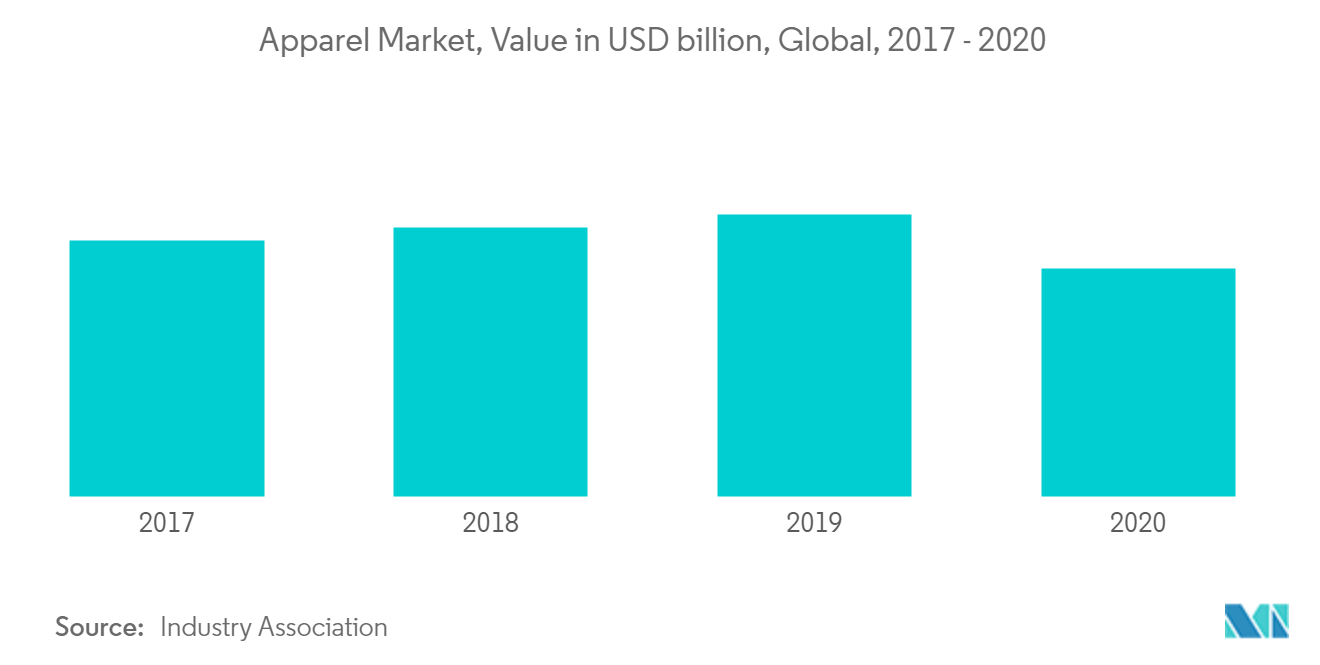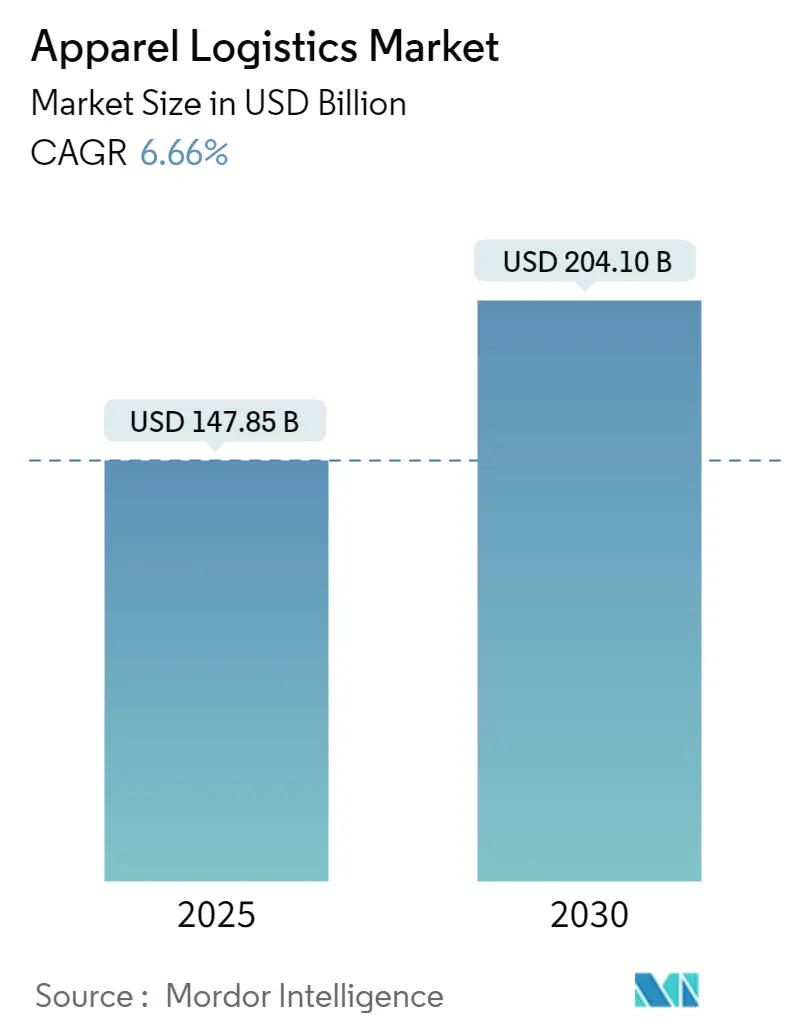
| Study Period | 2020 - 2030 |
| Market Size (2025) | USD 147.85 Billion |
| Market Size (2030) | USD 204.10 Billion |
| CAGR (2025 - 2030) | 6.66 % |
| Fastest Growing Market | Asia Pacific |
| Largest Market | Asia Pacific |
| Market Concentration | Low |
Major Players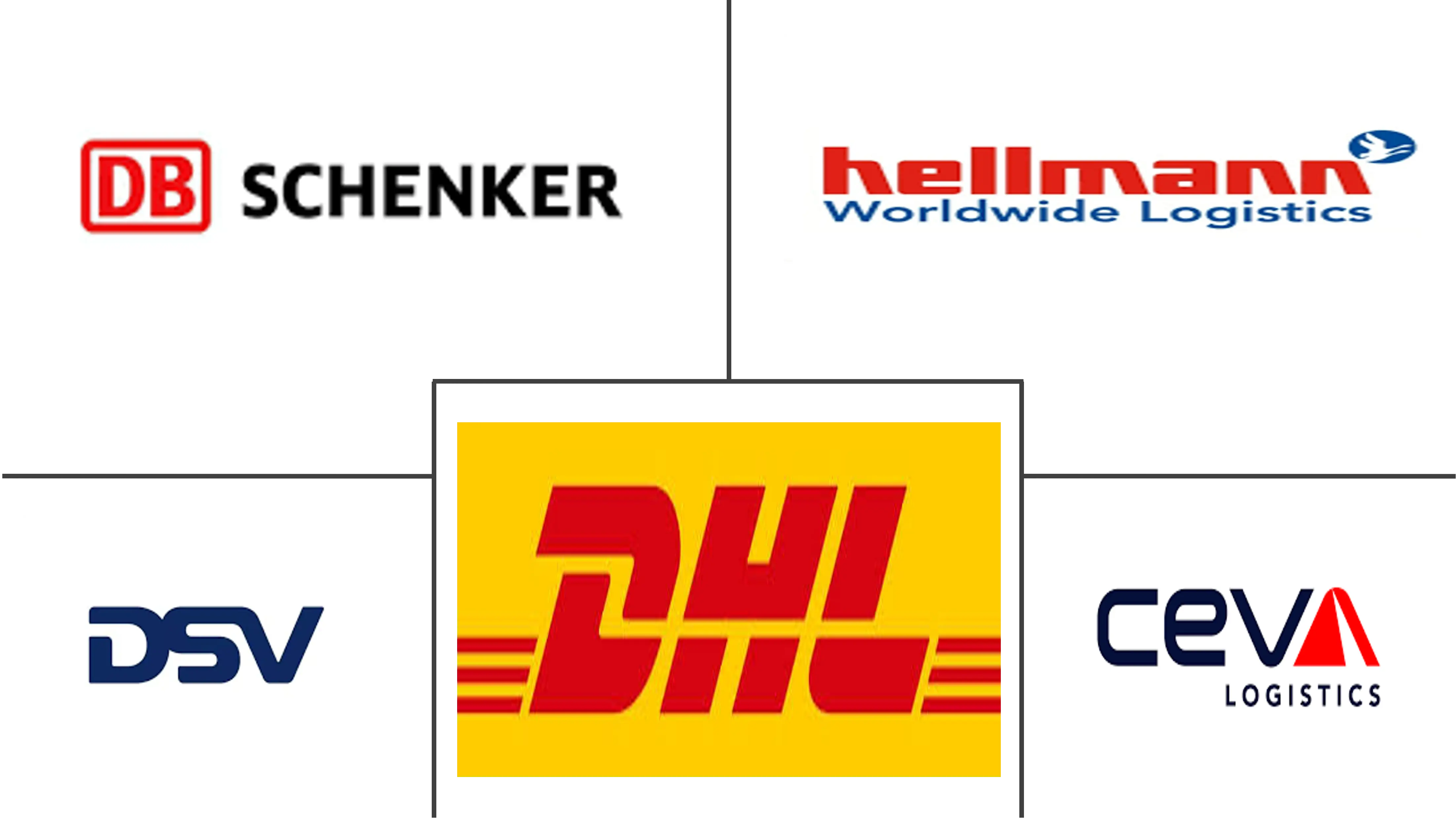
*Disclaimer: Major Players sorted in no particular order |
Apparel Logistics Market Analysis
The Apparel Logistics Market size is estimated at USD 147.85 billion in 2025, and is expected to reach USD 204.10 billion by 2030, at a CAGR of 6.66% during the forecast period (2025-2030).
Rapid replenishment cycles of the apparel industry are the main factor driving the market's growth. From retailers to manufacturers, apparel supply chains compete strongly to provide the latest trends and the best customer experience. Meanwhile, changing consumer expectations and fulfillment models pressure apparel businesses.
The COVID-19 pandemic caused lockdowns, line limitations, and breakdown of transportation organizations across regions. With the rapidly increasing cases, the overall apparel logistics market is being influenced from multiple points of view. The accessibility of the labor force is disturbing the inventory network of the apparel logistics market, as the lockdowns and the spread of the infection are forcing individuals to remain indoors.
Many leading fashion retailers have embraced the concept of performing multi-channel distribution within a single facility with a single information system, achieving dramatic improvements in labor productivity and inventory optimization. The apparel marketplace is evolving and reinventing itself regularly. New sales channels are being developed, requiring companies to continuously evaluate and remodel their logistics and transportation networks.
The global apparel industry is extremely dynamic due to the ever-changing fashion trends. Due to the intense competition, apparel companies are implementing new technologies, such as data analytics and AI. The apparel industry has massive outsourcing operations that provide logistics players with considerable opportunities in domestic and international operations, making it a highly competitive industry. Any disruption in the supply chain leads to a huge loss for apparel companies. Thus, to have a minimal impact on their supply chain, apparel companies usually prefer outsourcing their operations to logistics players.
Apparel Logistics Market Trends
Growing Online Apparel Sales and Changing Consumer Behavior
In June 2021, the fast-fashion e-commerce site, shein.com, was the most visited in the fashion and apparel category worldwide, accounting for 3.29% of desktop traffic. The e-commerce portal of the Swedish clothing retailer HM ranked second, with 1.75% visits. In 2020 and 2021, online apparel retail sites experienced a sales increase due to their digital market presence. This effect has fuelled changes in the approach of the market players, which may be expected to continue in the coming years, with more emphasis on the growth of e-commerce, mobile shopping, and meeting ever-rising expectations of personalization among customers.
Based on the yearly percentage growth in terms of website traffic, shein.com emerged as the leading fast-fashion retailer website in the United States in Q4 2020. While consumers frequently visit websites to compare prices and products, global online platforms plan to expand their fashion brand partnerships and develop additional engagement methods to stay competitive in the digital shopping space. To handle the growing online orders, third-party logistics companies are absorbing millions of sq. ft of space and letting it out to consumer goods, e-commerce, manufacturing, and apparel companies.
Growing Apparel Market Boosting the Growth of Apparel Logistics
Revenue generated by the apparel market steadily increased through the study period. In 2020, the market revenue was approximately USD 1.46 trillion. Consumer technology brands have long targeted online shoppers in Australia, Japan, and South Korea. However, brands in the apparel and beauty sectors are also targeting other regions. Hence, brands may continue focusing on localization and catering to millennial customers who are the key buyers of these products.
The Y-o-Y growth rate for apparel and footwear experienced severe losses in 2020. Against the backdrop of the COVID-19 pandemic, growth declined by a total of over 10%. Sporting goods and mass/club retail grew in 2020. Global sports apparel and footwear brands like Nike and Adidas are ditching other regions and increasing their production in emerging Southeast Asian countries like Vietnam, offering a positive outlook for transportation companies and other third-party logistics service providers.
Apparel Logistics Industry Overview
The apparel logistics market is fragmented with the presence of large global players and small- and medium-sized local players. Some of the key players occupy most of the market share. Most global logistics players have a retail and apparel logistics division to meet the market needs and demand. Additionally, local players are increasingly enhancing their capabilities in terms of fleet size, service offerings, products handled, and technology. The surging e-commerce sales are creating opportunities and challenges for logistics companies in terms of speed, delivery, etc. Global companies with high capital and assets can invest in advanced storage spaces and fulfillment centers and benefit from this scenario. On the other hand, regional and local players are coming up with better sector solutions to support the needs of the production companies and retailers.
Apparel Logistics Market Leaders
-
Ceva Logistics
-
DB Schenker
-
Deutsche Post DHL Group
-
DSV
-
Hellmann Worldwide Logistics
- *Disclaimer: Major Players sorted in no particular order
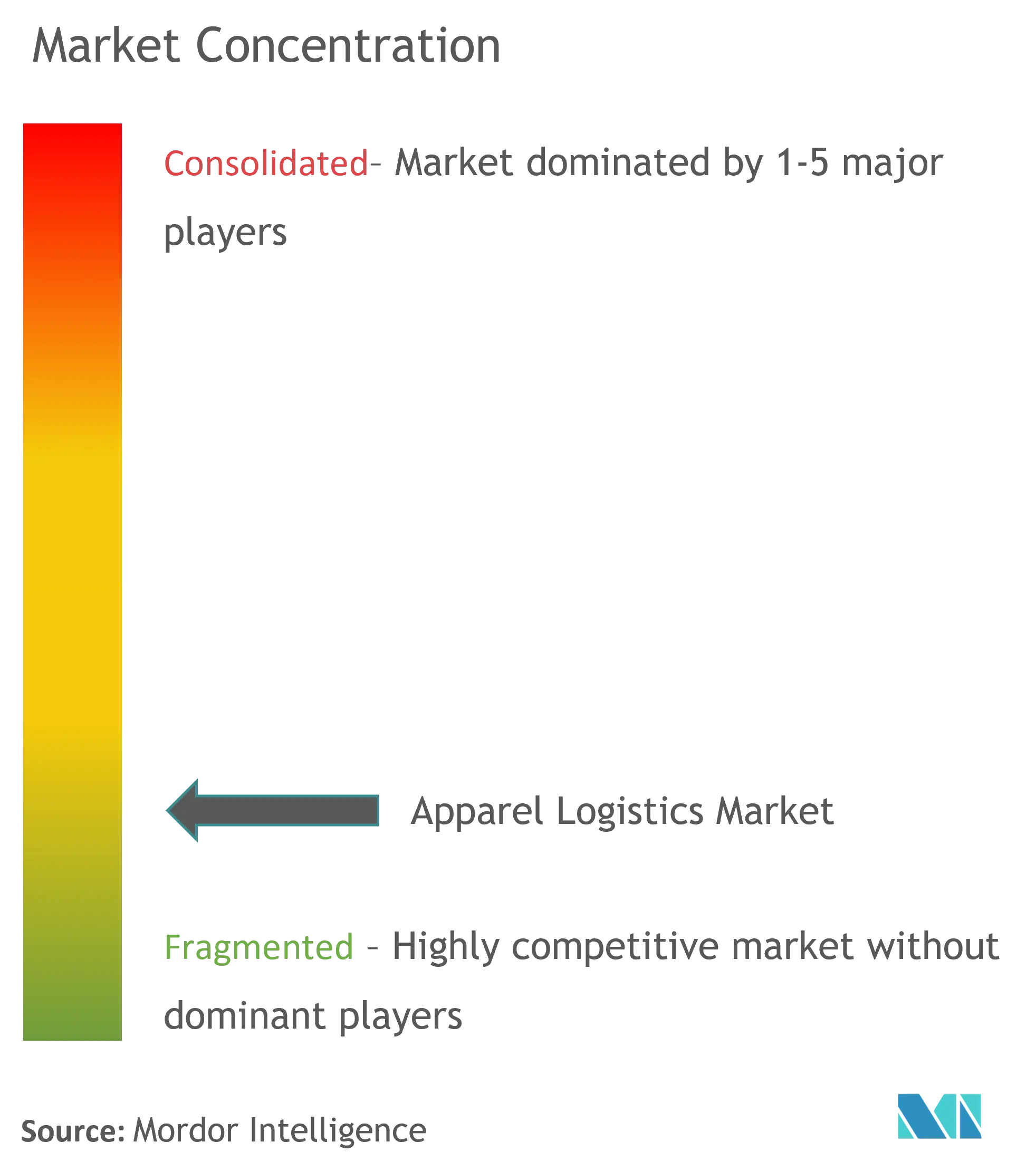
Apparel Logistics Market News
- November 2021 - DHL sponsored a stage of TGC for the first time in the international logistics industry, offering an express ticket to style worldwide. In this project, DHL teamed up with "FASBEE", a global fashion e-commerce site, to enable people overseas to purchase products introduced on the sponsored stage of Mynavi TGC 2021 A/W.
- November 2021 - DSV and New Balance agreed to expand their long-standing collaboration. With this new agreement, DSV plans to triple the volume stored and distributed for New Balance. A tailor-made and automated 60,000 sq. m DSV warehouse facility has been upgraded to accommodate this significant volume increase. The warehouse facility has already been inaugurated.
Apparel Logistics Industry Segmentation
Apparel logistics cater to the supply chain needs of apparel manufacturers and retailers. The report provides a complete background analysis of the apparel logistics market, including an assessment of the sector and its contribution to the economy, market overview, market size estimation for key segments, the impact of COVID-19 on the market, key countries, emerging trends in the market segments, market dynamics, and key goods flow statistics.
The market is segmented by service (transportation, warehousing, inventory management, and other value-added services) and geography.
| By Service | Transportation | ||
| Warehousing, and Inventory Management | |||
| Other Value-added Services | |||
| By Geography | Asia-Pacific | China | |
| Japan | |||
| India | |||
| South Korea | |||
| ASEAN | |||
| Rest of Asia-Pacific | |||
| North America | United States | ||
| Canada | |||
| Brazil | |||
| Mexico | |||
| Rest of Americas | |||
| Europe | United Kingdom | ||
| Germany | |||
| Italy | |||
| Spain | |||
| France | |||
| Rest of Europe | |||
| Middle-East and Africa | Saudi Arabia | ||
| South Africa | |||
| Rest of Middle-East and Africa | |||
Apparel Logistics Market Research FAQs
How big is the Apparel Logistics Market?
The Apparel Logistics Market size is expected to reach USD 147.85 billion in 2025 and grow at a CAGR of 6.66% to reach USD 204.10 billion by 2030.
What is the current Apparel Logistics Market size?
In 2025, the Apparel Logistics Market size is expected to reach USD 147.85 billion.
Who are the key players in Apparel Logistics Market?
Ceva Logistics, DB Schenker, Deutsche Post DHL Group, DSV and Hellmann Worldwide Logistics are the major companies operating in the Apparel Logistics Market.
Which is the fastest growing region in Apparel Logistics Market?
Asia Pacific is estimated to grow at the highest CAGR over the forecast period (2025-2030).
Which region has the biggest share in Apparel Logistics Market?
In 2025, the Asia Pacific accounts for the largest market share in Apparel Logistics Market.
What years does this Apparel Logistics Market cover, and what was the market size in 2024?
In 2024, the Apparel Logistics Market size was estimated at USD 138.00 billion. The report covers the Apparel Logistics Market historical market size for years: 2020, 2021, 2022, 2023 and 2024. The report also forecasts the Apparel Logistics Market size for years: 2025, 2026, 2027, 2028, 2029 and 2030.
Our Best Selling Reports
Fashion Logistics Industry Report
Statistics for the 2025 Apparel Logistics market share, size and revenue growth rate, created by Mordor Intelligence™ Industry Reports. Apparel Logistics analysis includes a market forecast outlook for 2025 to 2030 and historical overview. Get a sample of this industry analysis as a free report PDF download.



